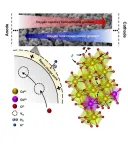(Press-News.org) With the Global Nutrition and Hydration Week 2024 starting today, researchers have announced an intriguing discovery – consumers generally prefer AI-generated images of food over real food images, especially when they are unaware of their true nature. The new findings have been published in Food Quality and Preference.
According to the researchers, the results suggest that AI-generated food visuals excel at enhancing the appeal of depicted foods by leveraging key features such as symmetry, shape, glossiness, and overall lighting and colour. All of these are known to contribute significantly to the attractiveness of food imagery.
Even subtle tweaks in positioning may enhance the appeal of AI-generated food images. Lead author Giovanbattista Califano (Department of Agricultural Sciences, University of Naples Federico II) explained: ‘As humans, we tend to feel uneasy with objects pointing towards us, interpreting them as threats, even when it’s just food. When tasked with replicating food photos featuring items pointing at the viewer, such as a bunch of carrots or a piece of cake, the AI often positions the food so that it doesn’t directly point at the viewer. This warrants further studies, but it's plausible that this approach enhances the perceived attractiveness of the depicted food.’
In the study, the researchers asked 297 participants to rate real or AI-generated food images on a scale from “Not at all appetizing” to “Extremely appetizing.” The images depicted a range of natural, processed, and ultra-processed foods, from apples and carrots to chocolate milkshakes and potato fries. When participants were told how each image had been created—whether through photography or AI—they tended to rate real and AI-generated versions equally appealing. However, when participants were unaware of the image creation process, the AI-generated version was consistently rated as significantly more appetizing than the real food image.
Study supervisor and co-author Professor Charles Spence (Department of Experimental Psychology, University of Oxford) said: ‘While AI-generated visuals may offer cost-saving opportunities for marketers and the industry by reducing the cost of commissioning food photoshoots, these findings highlight potential risks associated with exacerbating ‘visual hunger’ amongst consumers—the phenomenon where viewing images of food triggers appetite and cravings. This could potentially influence unhealthy eating behaviours or foster unrealistic expectations about food among consumers.’
Additionally, the researchers also found that AI-generated images tend to depict foods to appear more energy-dense compared to the originals, particularly in the abundance portrayed. For instance, AI may increase the number of fries in the image or add more whipped cream to a dessert. Given that humans have an evolutionary drive to pay more attention to energy-dense foods, this raises concerns that widespread dissemination of such idealized food images could promote cue-induced eating of unhealthy foods.
Furthermore, with the global movement towards more sustainable consumption patterns, including the promotion of ‘ugly’ fruits and vegetables, there is a concern that constant production of AI-enhanced food images might nudge consumers towards an unrealistic standard of how natural foods should look, potentially harming sustainability efforts.
# # #
This article, “Assessing the visual appeal of real/AI-generated food images”, by Giovanbattista Califano and Charles Spence, has been published online in Food Quality and Preference: https://doi.org/10.1016/j.foodqual.2024.105149
# # #
For media enquiries and interview requests contact:
Giovanbattista Califano (giovanbattista.califano@unina.it)
Charles Spence (charles.spence@psy.ox.ac.uk)
Images
All images used in the study are accessible in Appendix A. Supplementary data through the following link: https://doi.org/10.1016/j.foodqual.2024.105149
About the University of Naples Federico II (www.unina.it)
The University of Naples Federico II is a public research university in Naples, Campania, Italy. Established in 1224 and named after its founder, Frederick II, it is the oldest public, secular, non-sectarian or state-funded university in the world, and one of the world’s ten oldest universities in continuous operation.
In 2024, the University of Naples Federico II proudly celebrates its 800th anniversary, marking eight centuries of academic excellence, innovation, and cultural impact. With over 90,000 students in 2022 it is among the largest universities in Europe.
Among those who have attended the University of Naples Federico II are Italian presidents Enrico De Nicola, Giovanni Leone and Giorgio Napolitano; philosophers Giordano Bruno, Benedetto Croce and Nicola Abbagnano; astronaut and commander of the International Space Station Samantha Cristoforetti.
About the University of Oxford (www.ox.ac.uk)
Oxford University has been placed number 1 in the Times Higher Education World University Rankings for the eighth year running, and number 3 in the QS World Rankings 2024. At the heart of this success are the twin pillars of our ground-breaking research and innovation and our distinctive educational offer.
Oxford is world-famous for research and teaching excellence and is home to some of the most talented people from across the globe. Our work helps the lives of millions, solving real-world problems through a huge network of partnerships and collaborations. The breadth and interdisciplinary nature of our research alongside our personalised approach to teaching sparks imaginative and inventive insights and solutions.
Through its research commercialisation arm, Oxford University Innovation, Oxford is the highest university patent filer in the UK and is ranked first in the UK for university spinouts, having created more than 300 new companies since 1988. Over a third of these companies have been created in the last five years. The university is a catalyst for prosperity in Oxfordshire and the United Kingdom, contributing £15.7 billion to the UK economy in 2018/19, and supports more than 28,000 full-time jobs.
END
BOSTON – (March 11, 2024) Mass General Brigham is establishing the Implantable Brain-Computer Interface Collaborative Community (iBCI-CC). This is the first Collaborative Community in the clinical neurosciences that has participation from the U.S. Food and Drug Administration (FDA).
BCIs are devices that interface with the nervous system and use software to interpret neural activity. Commonly, they are designed for improved access to communication or other technologies for people with physical disability. Implantable BCIs are investigational devices ...
Political anger and cynicism are rising in the United States and in many democracies worldwide, and both are associated with exposure to political attacks on social media, a new University of Michigan study shows.
Americans use social media to find information and news about politics, but much of the content they see in their feeds is hostile, uncivil and attacking, said lead author Ariel Hasell, assistant professor of communication and media and an affiliate of the Center for Political Studies at the U-M Institute for Social Research.
Hasell ...
FINDINGS
In a new UCLA Health study, 25 medical students pursuing emergency medicine were interviewed about their experiences working in an emergency room during clinical rotations. Four themes were identified in their answers: watching difficult interactions between patient and care team and among the care team was distressing; women participants found that culture to be exclusionary; traits – like assertiveness and self-advocacy – were favored; and access to mentors, representation, and exposure to environment influenced interest towards the specialty. Most of the medical students interviewed -- 21 ...
The University of Houston College of Pharmacy is included in a $68.5 million funding package from the Cancer Prevention and Research Institute of Texas (CPRIT).
Ming Hu, Diana S-L. Chow Endowed Professor of Drug Discovery and Development, and Gregory Cuny, Joseph P. & Shirley Shipman Buckley Endowed Professor of Drug Discovery, received $1.4 million to fight familial adenomatous polyposis (FAP), a devastating and rare genetic disorder of the gastrointestinal tract that can cause hundreds or thousands of polyps inside the colon ...
UNIVERSITY PARK, Pa. — Each year between 200,000 and 270,000 children and youth enter foster care placements with child welfare services, and many more children receive child welfare services while remaining in their parent's care, according to the U.S. Department of Health and Human Services. Although many of these children have a documented history of abuse or neglect, children may respond differently to incidents of maltreatment or other potentially traumatic events. Incorporating a trauma screening — which assesses how trauma and maltreatment affected each child — into the child welfare evaluation process provides information that could be used to ...
Monitoring daily activity patterns using a wrist-worn device may detect early warning signs of Alzheimer’s disease, according to a new study led by researchers at the Johns Hopkins Bloomberg School of Public Health.
The researchers analyzed movement data from wristwatch-like devices called actigraphs worn by 82 cognitively healthy older adults who were participants in a long-running study of aging. Some of the participants had detectable brain amyloid buildup as measured by PET scan. Buildup of the protein amyloid beta in the brain is a key feature of Alzheimer’s disease.
Using a sensitive statistical technique, the ...
They published their work on new superionic mechanism in fluorite oxide electrolyte for low temperature protonic ceramic fuel cells in Energy Material Advances.
"The development of low-temperature and high-performance solid oxide fuel cells is imperative." said corresponding author Dr. Jianbing Huang, Associate Professor of the State Key Laboratory of Multiphase Flow in Power Engineering, Xi'an Jiaotong University.
Dr. Huang explained that protonic ceramic fuel cell has several significant advantages as an alternative solid oxide fuel cell ...
WASHINGTON, March 11, 2024 — For years, scientists thought some complex molecules could only be formed on Earth. But what if we found these kinds of molecules out in space after all? In this episode of Reactions, we explore new findings that show complex carbon ring structures can be formed in space, and what that might mean for biology, chemistry and our own chemical history! https://youtu.be/Jh_O5JP10aQ?si=HFvdSchFY95y4idV
Reactions is a video series produced by the American Chemical Society and PBS Digital Studios. Subscribe to Reactions at http://bit.ly/ACSReactions and follow us on Twitter @ACSReactions.
The ...
A research team at Microsoft has designed an efficiency tool called TaskMatrix.AI that can be used to accomplish a wide variety of specific AI tasks. TaskMatrix.AI connects general-purpose foundation models like GPT-4, the model behind ChatGPT, with specialized models suitable for certain tasks — much like a human project manager. This research was published Feb. 16 in Intelligent Computing, a Science Partner Journal.
Foundation models and specialized models usually have different mechanisms thus are not easily compatible. Rather than modifying and integrating existing models, TaskMatrix.AI bridges the gaps between them through application ...
A piece of rotting fruit is likely covered in hundreds if not thousands of microscopic roundworms, including C. elegans—a popular experimental model system for studying neurogenetics. With a lifespan of only a few weeks, C. elegans must reproduce quickly and often. The species is made up of hermaphrodites and males. The hermaphrodites have female bodies, can self-fertilize, and can mate with males. Recent research from of the Portman Lab at the Del Monte Institute for Neuroscience at the University of Rochester, found the males do not mate indiscriminately—they are selective about things like age, mating history, and nutrition.
“We ...




